Reservation. How US Indians survive and try to fight for their rights
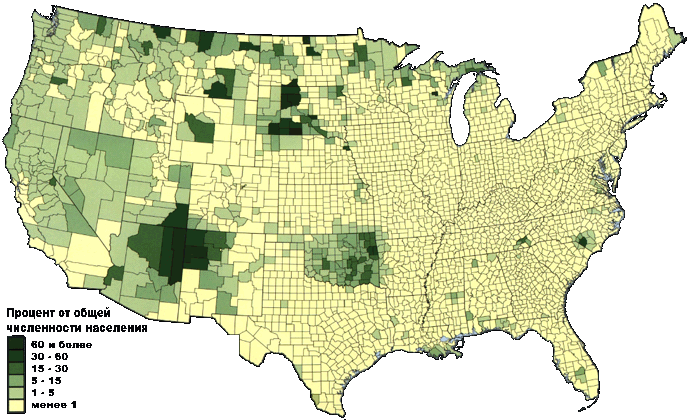
First reservations
The first Indian reservation appeared in the United States of America 29 August 1758, exactly 257 years ago. The territory of the modern state of New Jersey, where the idea of a reservation was introduced “innovative” for that time, was once inhabited by the Lenape Indians. In the thirties of the 17th century, the coastal lands of New Jersey attracted the attention of Dutch colonists and, thanks to the efforts of the latter, became part of the colony New Netherlands. The domination of people from the “country of tulips” ended in 1664, when British colonel Richard Nicholls annexed the Netherlands colony to the British possessions. It was in New Jersey that the Indians were recognized as "dependent peoples who do not have sovereignty over their territories." As they moved further inland and the development of new lands, the British, and then the Americans who replaced them, captured more and more new territories inhabited by Indians. Native Americans were driven into reservations, but this was explained as a boon for the Indians themselves. The US Congress confirmed the power of the Indian tribes, but only over the territories reserved for them. Of course, the best lands were occupied by the Americans themselves, and the Indian population was partly knocked out in clashes, and partly — it was pushed back to less convenient land for farming.
Reservation as a way to solve the "Indian question"
After Andrew Jackson became the US president, an ardent supporter of the concept of Indian relocation to the desert lands of the South-West, the US government began to relocate the Indians from the South-East of the USA to the South-West. The path that the "red-skinned" was to go through entered history as "Road of Tears". Only a decade from 1828 to 1838. over 80 thousands of Indians were resettled to the west of the r. Mississippi, and in general the forced relocation of the Indians lasted until the end of the 1870's. During the resettlement killed tens of thousands of Indians. So, only during the resettlement of the Choctaw tribe, which was held in 1831-1833, at least 3-6 thousand people died. Some Native American tribes tried with weapons in the hands of resisting American politics - including the Seminoles, whose charismatic leader, Osceola, was immortalized by Main Reed. The resistance of the Indians entered the history of North America and was romanticized by many writers, becoming an example of the national liberation struggle for other countries, continents and peoples. Of course, the Indians behaved extremely cruelly in the process of wars with the American government and settlers, but they can be understood - they defended their own land, on which they lived for thousands of years and which they had been deprived of previously unknown aliens who thought only of their own political and economic advantage.
In the policy of arranging reservations, the American leadership acted according to the principle of "divide and conquer." Thus, small tribes were driven into one reservation, and since they did not understand each other (the languages of the North American Indians, still poorly studied, include a number of language families), they were forced to switch to English as a language of international communication. On the other hand, several reservations were created at once for large tribes in order to separate them as much as possible and to prevent the possible emergence of hotbeds of the national liberation struggle. So, Dakota were placed in 11 reservations, and Iroquois - in 9 reservations.
Until the end of the First World War, the reservation Indians did not have US citizenship, and only in 1919 did those of them who served in the active army receive the right to become American citizens. Five years later, in 1924, the American leadership matured to grant citizenship to the entire Native American population. However, the socio-economic situation of Indian reservations remained extremely unsatisfactory. Actually, even now Indian reservations are the most economically, socially and culturally underdeveloped territories of the United States. Reservations are faced with a numerous set of problems, in general, rather not characteristic of the developed countries of the modern world, even for their peripheral regions. The reason for this - in the specifics of the American national policy on the indigenous population of the United States.
Initially, the US government ousted Indians from areas of significant agriculture, but the development of the mining industry made it necessary to pay attention to those lands that had not previously caused particular interest among the federal authorities. It turned out that the land allocated in the XIX century under Indian reservations, hide the rich natural resources. However, the welfare of the Indian population from the exploitation of natural resources on the lands of reservations, is not improving. The development of natural resources brings additional problems - the environment is deteriorating, agriculture is being harmed, the number of cancer patients is growing. “Reservations were originally nothing more than advertised concentration camps,” said (http://ria.ru/world/20150807/1168843710.html) in an interview with RIA-News the elder of the Chiroki Birds clan, Masha White Perot, who noted that according to his data, the policy on indigenous peoples is much better established in the Russian Federation than in the United States. Indeed, despite the numerous socio-economic problems that Russia has faced over the past decades, the country does not have open discrimination against national minorities by the authorities of the Russian state. The national minorities of Siberia and the Far East, the Volga region and the Urals, the North Caucasus and the Crimea have the opportunity to develop safely, use their own languages, develop and promote culture. That is, they have what the American Indians and other indigenous peoples of North America — the Eskimos, Aleuts, and Hawaiians — are practically deprived of.
The most problematic areas of the United States
Today, there are 550 Indian tribes officially recognized by the federal government in the United States. The total number of American Indians is about 5 million, 2 / 3 of whom live in 275 Indian reserves. Formally, US law recognizes state rights for reservations, but for some reservations, certain benefits and exemptions are in place - in particular, gambling is allowed. The latter is largely the main source of income for residents of many reservations, along with tourism. In addition, the Indians have the right to excise-free trade in alcohol and tobacco products on the territory of reservations. But these measures, which seem to be designed to help raise the standard of living of the indigenous people of the United States, at the same time bring much evil to the inhabitants of reservations. It is well known about the colossal problem of alcoholism among the American Indian population.
Indian Reservation is a complete set of social issues. First, the Indians of the reservation, due to the preservation of the remnants of the traditional way of life, still have a larger number of children than the residents of the United States as a whole. The average age of an Indian is 29,7 years, and an American is 36,8 years. But this is connected not only with a large number of children and young people, but also with the early death rate of the Indian population. In Indian reservations, infant mortality is five times the average for the United States as a whole. Almost every fourth Indian child dies. Indians die of diabetes, pneumonia, and influenza two times more often than other Americans. In the reservations, next to which uranium mines are located, oncological diseases become one of the main causes of death. Nearly a quarter of Amerindian families live below the poverty line, among them there is a high level of illiteracy, and those with higher education only 16%, and this despite the possibility of free admission to universities for indigenous people. What can we say about the preservation of the national culture, which has become only a commodity for sale in those reservations that are visited by tourists. 72% of Indians do not speak their national languages, which indicates the gradual extinction of the Indian languages of North America and Indian culture. Native American social activists are trying to fight for the rights of tribesmen and constantly remind the world of the many problems faced by the inhabitants of reservations. But the level of protest sentiment among the Indian population is still significantly lower than among African Americans. And this is explained not by the more favorable conditions for the existence of Indians, but by the social isolation of the latter from “big America”, in combination with the habit of idleness at the expense of tourists and state benefits, alcoholization of a significant part of the male reservation population.
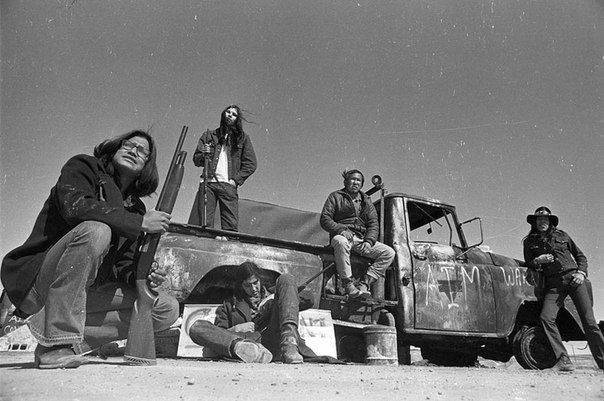
Attempts to consolidate the Indians in the framework of modern political structures began in the first half of the twentieth century. In 1944, the current organization was created - the National Congress of American Indians (NCAI) (English National Congress of American Indians, NCAI), which aims to protect the rights and interests of American Indians, Aleuts and Eskimos of Alaska. Her goal was to proclaim a response to the assimilation policy pursued by the US government that violates all the treaty obligations of the American state towards indigenous peoples. The organization is a political association of federally recognized American Indian tribes and Alaska Native peoples. The main objectives of the organization's activities are proclaimed: guaranteeing the rights and freedoms of US Indians; the expansion and improvement of education in the Indian regions of the country; improving the employment situation of the Indian population; improving the quality of medical care; protection of Native American cultural values and languages; Ensuring an equitable approach to the consideration of the requirements of the indigenous people of the United States. NCAI succeeded in creating reservations for Alaska’s indigenous population in 1950, and in 1954 won a campaign against the transfer of civilian and criminal jurisdiction over the Indian population of reservations. However, later, within the NCAI, the struggle of the more radical part of the congress, represented by the Native American youth, began against the moderate line of leadership of the association, which included traditional tribal leaders. As a result of this struggle, the American Indian Movement and the National Council of the American Indian Youth emerged, which came out from more radical positions and repeatedly resorted to protest actions, including violent ones, against the American government and its policies on Indian reservations.
The Native American movement was founded in July 1968 in the city of Minneapolis, Minnesota. The movement proclaimed its goal to protect the rights of the indigenous people of the United States, including the economic independence of the Indian population, the protection of traditional Indian culture, the fight against racism against the Indian population by the authorities and police structures, the restoration of rights to use tribal lands illegally transferred into the ownership of whites. The Native American movement that has existed since 1968 has never had such scope as the Nation of Islam, Black Panthers and other social and political organizations and movements of black US citizens. The main objective of the Movement of American Indians was to prevent the illegal use by American companies of land allocated to Indians for economic enrichment. On this basis, there were constant conflicts between Native American activists and US security forces.
Later, branches of movement also arose in Canada. Since the end of 1950's. activists of the Movement of American Indians moved to radical protest actions. Thus, from November 1969 to July 1971, the seizure of Alcatraz Island was carried out, and in October 1972 a march to Washington was undertaken. In the middle of 1970's. Dai's influence on the state Indian population has increased, and at the same time ties with African American political organizations have strengthened. However, in 1978, the central DAI ceased to exist due to internal contradictions, but certain movement groups continue to function in various US states. In 1981, activists seized part of the Black Hills in South Dakota, demanding that the US leadership return the territory to the Indians. American intelligence agencies view the Amerindian Movement as an extremist organization and periodically carry out repression against Native American activists.
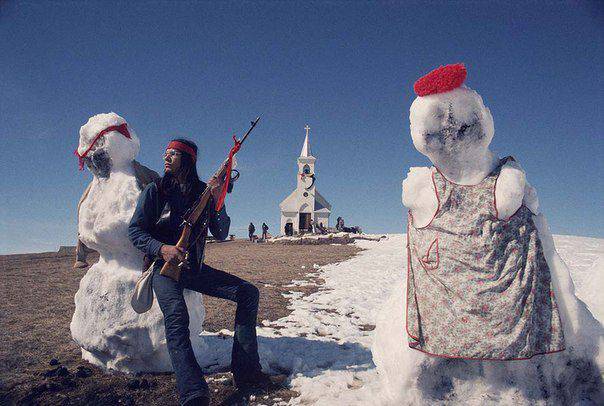
Capture Wounded Knee
The most famous action of the Movement of American Indians was the capture of 27 in February of 1973, the settlement of Wounded Knee (“Wounded knee”) in the Pine Ridge reservation area in South Dakota. For the Indian population, Wounded Knee is a significant place. Here 29 December 1890 was the last major battle of the Indian Wars, dubbed the “Slaughter on the Wounded Knee Creek”. Among the Indians, a new religion, the Spirits Dance, appeared, in accordance with which Jesus Christ must return to earth in the form of an Indian. The spread of this religion alerted the American authorities, who saw in it the potential danger of the emergence of a new Native American armed resistance. In the end, the authorities decided to arrest the leader named Sitting Bull. However, in a shootout with police, the Sitting Bull was killed. Then his supporters left the Cheyenne River Reservation and headed to the Pine Ridge Reservation, where they were to seek refuge. 29 December 1890. A detachment of American soldiers in 500, soldiers from the 7 Cavalry Regiment attacked the Minh-skinned and Xunpup tribes, who were part of the Lakota people. As a result of the operation, at least 153 Indians were killed, including women and children. According to other estimates, about 300 Indians, mostly unarmed and unable to offer serious resistance to the military, died at the hands of the US military.
In turn, the Indians, even taking into account the incomparability of forces, managed to destroy the 25 soldiers of the American Cavalry Regiment. Hugh McGinnis, who served as a private in the 7 Cavalry Regiment, later recalled: “General Nelson Miles, who visited the site of the massacre after a three-day blizzard, counted approximately 300 snow-covered bodies in the vicinity, including at a considerable distance. He was horrified to see that the soldiers were pursuing and protecting ruthlessly killing defenseless children and women with babies in their arms ... ” As it turned out, the formal reason for the slaughter was that an Indian named Black Coyote did not surrender his rifle to the American soldiers. The regimental commander, Colonel Forsyth, decided that there was armed disobedience and ordered the shooting of a camp of Indians, in which there were only women, children, and a small number of men who had grown weak as a result of a long transition. Meanwhile, Black Coyote was just a deaf person and could not hear the order to surrender his weapon. Subsequently, General Miles accused Colonel Forsyth, who directly commanded the operation, in the shooting that took place, but then the latter was again reinstated and even later received the rank of major general. In memory of the Indians, the Lakota massacre at Wounded Knee remained as yet another manifestation of cruelty on the part of the American government, especially since unarmed women and children became its victims. The perpetrators of the tragedy were never punished; moreover, about twenty soldiers and officers of the American army who participated in the operation received government awards. Moreover, the white public of the United States took the tragedy quite positively, since it had long disliked the Indians and considered them a potential source of crimes against the white population. American propaganda also played a role in this, depicting the incident as the elimination of an extremist religious sect that posed a danger to American society. In 2001, the National Congress of American Indians demanded the repeal of acts of awarding American soldiers who participated in the operation against the Indians at Wounded Knee, but the US leadership did not respond to this appeal.
After 83, Wounded Knee was the site of another clash between the Indians and the American security forces. Wounded Knee was invaded by followers of the Native American Movement of approximately 200-300 people led by Russell Means and Dennis Banks. Native American activists introduced traditional tribal rule in the settlement and declared the village an Indian state free from Europeans. 11 was taken hostage by local activists, seized the church and dug trenches on the hill. After that, activists made claims against the US government - checking all contracts concluded at various times between the American authorities and Indian tribes, investigating the relationship between the US Department of the Interior and the Bureau of Indian Affairs for the tribe, replacing members of the tribal council and activists of the Movement of Amerindians. The next morning began with the blocking of all access roads to Wounded Knee by American police forces numbering more than 100 officers. Two US senators flew to the settlement, who entered into negotiations with the rebels. The action turned into a conflict with the use of weapons that lasted 71 day. Police forces, the FBI and the army engaged in an exchange of fire with the activists who captured the settlement. Lawyer William Kunstler arrived at the settlement, at one time defending such cult figures of the American leftist movement as Martin Luther King, Malcolm X, Bobby Seal, Stockley Carmichael. The events in Wounded Knee were publicized throughout the United States and were described by many contemporaries as the “new Indian war” of the indigenous people of the States against the American government.
- Leonard Peltier
In the end, 8 in May, the resistance of Indian activists ended - a large role was played by the National Council of Churches, through whose mediation an agreement was reached on the surrender of the rebels. After the agreements reached, the US authorities decided to satisfy the charges against activists against members of the Indian tribal council and revise the treaty at Fort Laramie concluded in 1868, according to which the Sioux received a large territory of North and South Dakota, Wyoming, Nebraska and Montana. The insurgents Buddy Lamont and Frank Clearwater became the victims of the clashes in Wounded Knee, and the leader of the rebel movement Dennis Banks was forced to spend ten years in the underground, hiding from justice. Another rebel leader, Russell Means, ran for president of the tribe Ogla-Siou in 1974, vying with Dick Wilson. Wilson got more votes on 200, but Minns contested the election results, accusing his opponent of fraud. In the case of the incident in Wounded Knee, Minnes was acquitted, but in 1975 he again appeared before the court - this time on the charge of murder. But was acquitted.
But they condemned another Indian activist - Leonard Peltier. Coming from Turl Mountain Indian Reservation in North Dakota, Peltier was born in 1944 in the family of the Ojibwean after his father and his Sioux people by his mother. 26 June 1975 A firefight took place in Wounded Knee, which killed FBI agents Jack Coler and Ronald Williams and Indian Joseph Kilzright Stanz. According to the materials of the investigation, the cars of the FBI agents came under long shelling on the territory of the reservation, and as a result were killed. It was established that the rifle from which the special services were fired belonged to a local 31-year-old resident Leonard Peltier. A squad of 150 FBI agents, police and commandos detained thirty Indians, including women and children. Peltier managed to escape and only 6 in February of 1976 was arrested in Canada and extradited to the USA. The grounds for issuing were the testimony of an Indian Myrtle Poor Bear, who introduced herself as Peltier's girlfriend and accused him of killing FBI employees. Peltier himself called the testimony of a woman a forgery. However, in April 1977. Mr. Peltier was sentenced to two life sentences. Since then, the Native American activist has been imprisoned - despite the intercession of a number of prominent public figures from around the world, from Mother Teresa to the Dalai Lama, from Yoko Ono to Naomi Campbell. Even Mikhail Gorbachev spoke in support of Peltier. Nevertheless, Peltier, although he is already 70 years old, is in prison and, apparently, will end his life in the dungeons of the American regime.
Republic of Lakota: the leader died, but his work lives
Pine Ridge is an Oglala-Lakota tribe reservation, covering 11 000 square miles (about 2 700 000 acres). This is the second Indian reservation in the United States. Eight districts — Eagle Nest, Pass Creek, Wakpamney, La Creek, Pine Ridge, White Clay, Medisen Ruth, Porcupine and Wounded Knee — live on 40 thousand people in an area approximately equal to Connecticut. . The population of the reservation - mostly young people, 35% of inhabitants younger than 18 years. The average age of residents of the reservation is 20,6. However, the responsibility for raising young generations of Indians lies with grandparents - many parents suffer from alcoholism or drug addiction, are in prisons, or have died prematurely. Great damage to the reservation caused by natural disasters. There are no banks, shops, cinemas in the reservation. Grocery store on the reservation - only one, in the village of Pine Ridge. Only on 2006, on the reservation did the motel open, designed for no more than 8 people. On the reservation there is only one public library located at Oglal Lakota College. Residents of the reservation are often the victims of fraud, including by representatives of banks working in nearby communities of the state. Taking advantage of the illiteracy and credulity of the Indian population, the inclination of many Indians to abuse alcohol and drugs, mercenary bankers involve Indians in fraudulent schemes, as a result of which indigenous people owe large sums of money to banks. The overwhelming majority of Indians are unemployed and are forced to live on state benefits. Thereby, the American government keeps them on a “financial needle” and turns them into dependent parasites who drink from idleness or “sit on the needle”. Naturally, not all of the thinking part of the Indian population like this situation of the indigenous people of the United States. Moreover, the United States openly mocks the national feelings of Indians. So, on images taken from the Indians of the Black Mountains, images of four American presidents were beaten out - precisely those that took land from the indigenous people of North America.
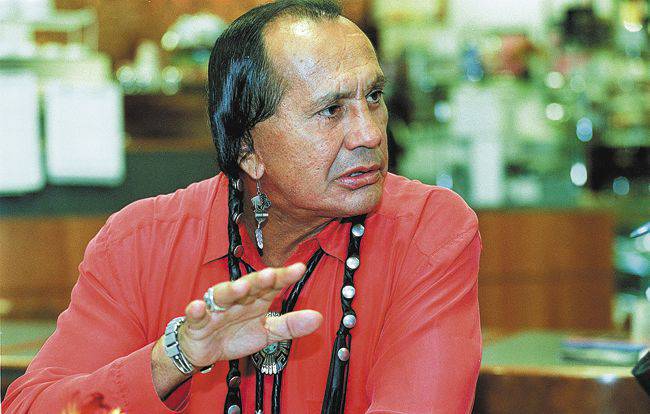
17 December 2007 A group of Lakota Indian activists proclaimed the independence of the Republic of Lakota in several tribal territories of the states of North Dakota, South Dakota, Nebraska, Wyoming and Montana. It was declared a waiver of US citizenship and payment of taxes. The Lakota supporters were led by the above-mentioned Indian social activist Russell Means (1939-2012) —in the past an activist of the Native American Movement, who was famous for bringing Wuned-Nee to a group of armed comrades-in-arms on Pine Ridge Reservation and introducing tribal governing body. The confrontation with the police and the army lasted 71 for a day and cost the lives of almost a hundred Indians, after which the remaining 120 people surrendered to the authorities. In the middle of 1980's. Minnes went to Nicaragua - to fight against the Sandinistas, whose policies were unhappy with the local Indians - Miskito. However, the detachment of Minns was quickly surrounded and deactivated by the Sandinistas, and the Indian activist himself was not touched and quickly released back to the United States. A trip to Nicaragua to fight on the side of the Contras provoked a sharply negative reaction from the American left-wing radical and left-wing public, who admired the Sandinista revolution and accused Mins of indulging bourgeois imperialism. Minnes had spoiled relations with many leading activists of the Native American movement who held pro-Anandist positions.
Then, for a while, Minnes did not engage in politics and focused on his film career. He starred in films in the Western genre, including playing the role of Chingachguk in the film adaptation of the novel The Last of the Mohicans. Minnes also wrote the book “Where White People Fear to Step” and recorded two “Indian Rap” audio albums. As a journalist Orhan Jemal recalls, “Friends of the already elderly Minns were persuaded to act in films (he was friends with Oliver Stone and Marlon Brando). And so the real Chingachguk appeared. It was easy for Minnes, he just played himself. Yet the final touch of his biography does not indicate that his blood cooled with age and he became a “useful member of society.” In 2007, he proclaimed the independence of the Lakota tribe. This demarche did not have any political consequences, it was just Minnes and his supporters who burned their American passports. And yet it allowed him to die, not as a banal American citizen, but as the Leader of the Redskins ”(quoted in: Jemal O. The Real Chingachguk // http://izvestia.ru/news/538265). In 2000-s. Russell Means reaffirmed himself as a political figure - this time with a plan to create an Indian public education, Lakota. The Lakota Republic has received worldwide fame, but it has caused a mixed reaction in the United States itself, especially from the American authorities and special services, who saw in this project another threat to the national security of the American state coming from Native American separatists. On the other hand, the work of Minns has always caused a negative reaction from the Indian traditional leaders, who closely cooperate with the federal authorities, and in fact simply bought by Washington. They accused Minns and his supporters of extremism and Maoism, they considered him a dangerous left radical, whose activities are more likely to harm the Indian reservation population.
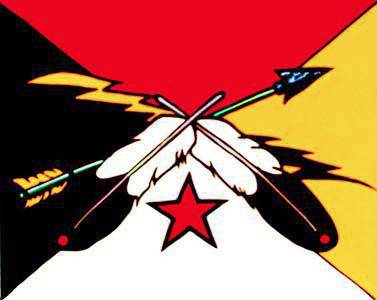 The project of the Republic of Lakota was conceived by Minns as an attempt to draw attention to the problems of residents of reservations. Indeed, in the territories inhabited by the Lakota, as Minnes noted, unemployment reached 80-85%, and the average life expectancy for men was 44, a year less - in the New World live only in Haiti. Of course, in the early deaths of Indians - men, alcohol is primarily guilty, but activists of the Republic of Lakota see this as the result of a deliberate policy of the US leadership to finally solve the "Indian question" by slow and smooth self-destruction of Indians. Alcoholism is a problem for 8 from 10 Indian families, 21% of prisoners in South Dakota are Indians, and teen suicide rates are 150% higher than the average in the United States. The 800% is higher than the average for the United States and the incidence rate of tuberculosis, by 500% - by the incidence of cervical cancer, by 800% - by diabetes. The reason for the spread of diabetes and heart disease is the supply of foods with a high sugar content, which are carried out in accordance with the Federal Food Supply Program. The overall standard of living of the population is much lower - at least 97% Lakota live below the poverty line, and some families are in such a plight that they still have to heat their houses with stoves. As a result, many old people who are unable to take care of heating for health reasons, die from hypothermia. Drinking water and sewage systems are not available in 1 / 3 reservation houses, 40% of houses do not have electricity, 60% do not have telephone communication. Approximately 17 people live in each house, while the number of rooms does not exceed two to three. The Lakota language is dying out, in which today only 14% of Indians speak, and then almost all of them are older than 65 years. It turns out that the indigenous population of one of the most economically powerful countries in the world lives at the level of the most backward states, literally on the verge of survival. Even a high birth rate in Indian families does not save them from extinction as a result of disease and the harmful effects of alcohol and drugs. Naturally, the plight of the Indian population causes the desire of the most politically active part of the Indians to make political demands. Moreover, otherwise people simply risk becoming extinct, like many other Native American ethnic groups in the United States. However, the US government does not seek to solve the problems of the Indian population, but represents political activists by separatists, extremists and terrorists, it is subject to criminal prosecution, or, at best, an information blockade.
The project of the Republic of Lakota was conceived by Minns as an attempt to draw attention to the problems of residents of reservations. Indeed, in the territories inhabited by the Lakota, as Minnes noted, unemployment reached 80-85%, and the average life expectancy for men was 44, a year less - in the New World live only in Haiti. Of course, in the early deaths of Indians - men, alcohol is primarily guilty, but activists of the Republic of Lakota see this as the result of a deliberate policy of the US leadership to finally solve the "Indian question" by slow and smooth self-destruction of Indians. Alcoholism is a problem for 8 from 10 Indian families, 21% of prisoners in South Dakota are Indians, and teen suicide rates are 150% higher than the average in the United States. The 800% is higher than the average for the United States and the incidence rate of tuberculosis, by 500% - by the incidence of cervical cancer, by 800% - by diabetes. The reason for the spread of diabetes and heart disease is the supply of foods with a high sugar content, which are carried out in accordance with the Federal Food Supply Program. The overall standard of living of the population is much lower - at least 97% Lakota live below the poverty line, and some families are in such a plight that they still have to heat their houses with stoves. As a result, many old people who are unable to take care of heating for health reasons, die from hypothermia. Drinking water and sewage systems are not available in 1 / 3 reservation houses, 40% of houses do not have electricity, 60% do not have telephone communication. Approximately 17 people live in each house, while the number of rooms does not exceed two to three. The Lakota language is dying out, in which today only 14% of Indians speak, and then almost all of them are older than 65 years. It turns out that the indigenous population of one of the most economically powerful countries in the world lives at the level of the most backward states, literally on the verge of survival. Even a high birth rate in Indian families does not save them from extinction as a result of disease and the harmful effects of alcohol and drugs. Naturally, the plight of the Indian population causes the desire of the most politically active part of the Indians to make political demands. Moreover, otherwise people simply risk becoming extinct, like many other Native American ethnic groups in the United States. However, the US government does not seek to solve the problems of the Indian population, but represents political activists by separatists, extremists and terrorists, it is subject to criminal prosecution, or, at best, an information blockade. In the autumn of 2008, Mr. Minns attempted, however to no avail, to stand for the president of the tribe, but only got 45% of votes, having lost the election campaign to Teresa Two Bulls, who received 55% of votes. In many ways, the loss of Minse was explained by the fact that his supporters lived outside the Pine Ridge Reservation and did not have the right to participate in the elections. In 2012, Mr. Russell Means died of throat cancer, but his brainchild - the Republic of Lakota - continues to exist in the form of a kind of virtual community, which increasingly takes on real features, "materializing" in the political life of the United States. On the territory of the Pine Ridge Reservation, where the Lakota tribe lives, Republican activists are trying to improve agriculture, have created a school where Indian children are taught the national language and culture. By the way, the official leaders of the Lakota tribe did not dare to support the project of the “madman” Minns. In 2008, they declared the continuity of the treaty with the United States, presenting the existence of the Republic of Lakota by the activities of a “small handful of extremists”.
The Republic of Lakota has to some extent become one of the symbols of anti-American resistance. The very fact of the emergence of Native American separatism in the United States attracted the attention of radical circles from around the world. Moreover, among the supporters of the republic there are not only and not even so much Indians as white Americans who are dissatisfied with the policies of their state and who consider the project of the late Mins to be an excellent way to state the urgent problems of American domestic politics. In 2014, in an interview with the NTV television company, the representative of the Lakota Indians, Payu Harris, said that the population of the reservation supported the people of Crimea in their choice and joining Russia. Payu Harris is known for creating his own money for the Lakota - mazakoyny. According to Payu Harris, money makes it possible to fight the American government. Although, of course, the US authorities in the person of the FBI have already managed to warn the Lakota Indians that printing their own money in the United States is an illegal activity. The Lakota Indians do not support the power of Washington, because they consider the activities of the American government openly hostile to the indigenous people of North America. The Republic of Lakota evokes sympathy not only among the Amerindians themselves, but also among so many caring residents of various states.
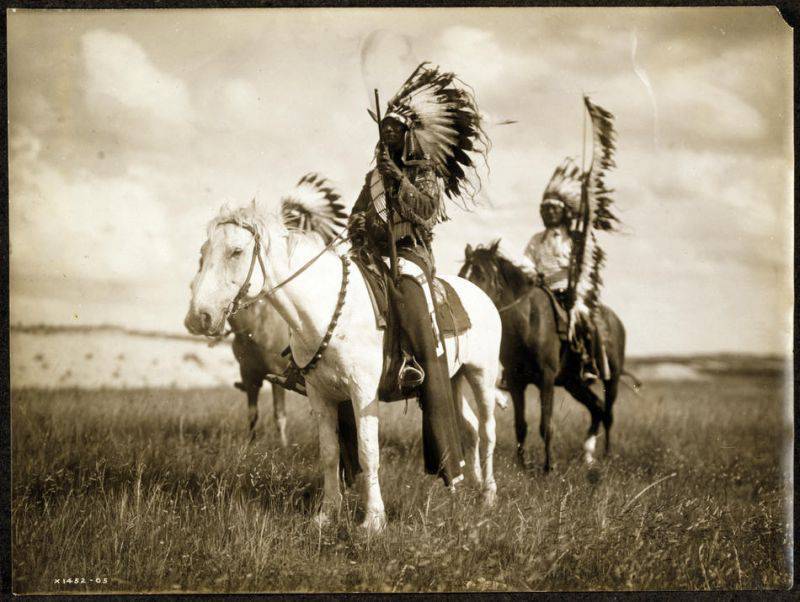
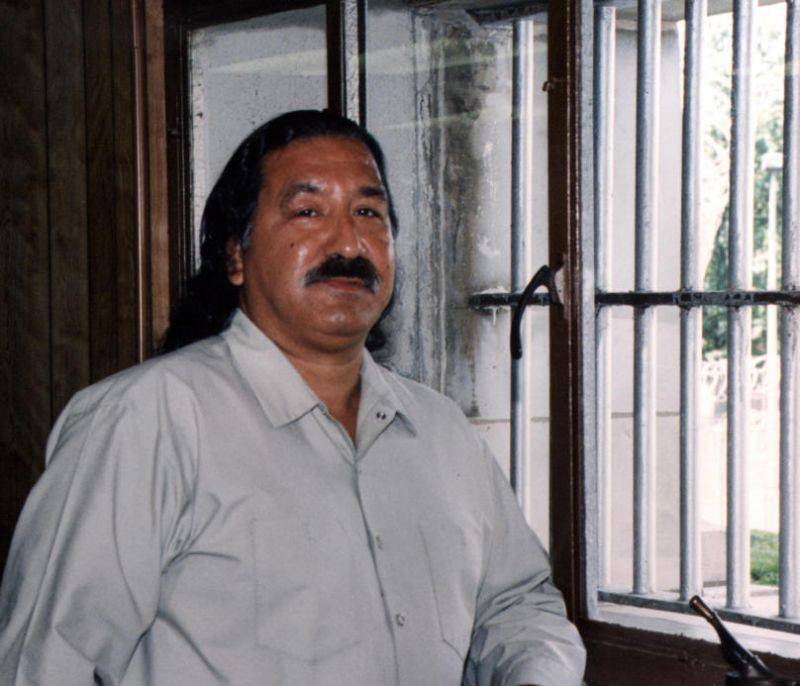
Information